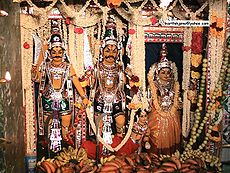- Sudalai Madan
-
Sudalai Madan or Madan, is a regional Tamil male deity who is popular in South India, particularly Tamil Nadu. He is considered to be the son of Shiva and Parvati. He seems to have originated in some ancestral guardian spirit of the villages or communities in Tamil Nadu, in a similar manner as Ayyanar.
Contents
God of the dispossessed
Madan's principal role is being a protector and a hero (Veeran). He is the divinity of the dispossessed. Madan is usually considered to be the caste deity of the Naidu, Pillai, Senguntha Mudaliyar, Pallar/Mallar, Konar, Thevar, Paraiyar, Nadar, and other castes found in the southernmost Tamil Nadu. This deity is very popular in the southern districts. Large Madan temples are rare. Madan shrines usually consist of simple stone platforms with stone pillars. They are usually located at the outskirts of the villages. Sometimes Madan is painted on the pillar and sometimes he is represented in sculpture form, but frequently those pillars are only white, daubed with red marks. When Madan is represented iconographically, he is usually standing in a threatening position, carrying weapons (Sickle, club, sword, cleaver, whip) in both hands.
Owing to the non-Vedic origin of this deity, rituals in most Madan temples are officiated by non-Brahmin priests.
Each Caste or families will have their own Madan temple in their villages.
Madathy Amman (Goddess Madathy)
Madathy amman shrines or pillars representing her are common in Madan temples. Goddess madathy is worshipped for good causes, such as for marriage and child birth, for good character in children, for a better society, etc. Madan is considered to be the husband of madathy, so that in Madan shrines, the pillars representing Madan are usually taller than those of the goddess. But madathy is considered to be powerful than madan because she is considered as mother of all and so the requests are placed before her, so that she would recommend her hubby to resolve the issue.
Harichandran
He is considered to be the son of Sivan and Parvati.
Madan is also related with Harichandran and is thus revered by all communities for his proverbial honesty and his adherence to only the truth at all stages of his life.
The story about Mada Samy tells of his birth on Kailasa, the mountain home of Siva and Parvathi. It is said that Devi Parvathi wanted a child, but Lord Siva had sworn celibacy. He had promised to be chaste at the request of the gods, since they had feared that his union with Parvathy would be so powerful it would shatter the universe. Siva suggests another way to have a child. He tells Parvathy to go to Patala Loka, the watery underworld, and to gather a spark from the sacred lamp that burns there. Parvathi did so, carrying the spark in the hem of her skirt.
When Parvathi Devi returned to Kailasa, she opened the folds of her skirt, and found that the spark had become a shapeless mass of tissue. she was really worried and pleaded shiva to give her a solution. Thus sudalai madan is often called as Mundan which means a person without head and other body parts. Siva asked Brahma to give the baby a shape. shiva gave life to the baby . He named him as sudalai madan because, he came to the world because of a lamp(sudar)and he was shapeless. The boy was blessed by everyone and he was brought up as their son.
Parvathi initially feeds the child on Amrita (the nectar of immortality), instead of on breast milk. So it is said that the child became immortal. However, the child also became desirous for solid food. He went to the cremation grounds ("sudalai") on Kailasa, and began to eat the bodies that were burning there. When he finished those, he began to eat everything around him, the other spirits, the animals, the trees, the ground itself etc. He feasted with a heavy appetite.
Because he ate so much, and since he had such a fondness for meat, it was decided that he ought not remain in Heaven. Siva instructed him to go to Earth, and to care for its people. Siva proclaimed that Mada Samy's protection and kindness would be re-paid with offerings of cooked food and drink, and thus he would always have a meal, as well as people who would pray to him. So Mada Samy came to earth, accompanied by a number of singers and dancers who were sent by Siva to see to his worship. Many of the Paraiyar and Kanniyar drummers who play during the rituals to Mada Samy claim descent from these divine musicians.
Outside India
Madan is also popular amongst certain segments of the Tamil diaspora in Sri Lanka, Singapore, Malaysia, Réunion and the French overseas territories in the Caribbean sea.
References
- Sudalai Madan temple and animal sacrifice
- Sudalai Madan amongst Indian origin Tamils
- South Indian Deities And Their Relative Following in Tamil Nadu
- Secularism and Religious Violence in Contemporary India
Hindu deities and texts Gods 
Goddesses Texts Categories:- Tamil deities
- Regional Hindu gods
Wikimedia Foundation. 2010.

